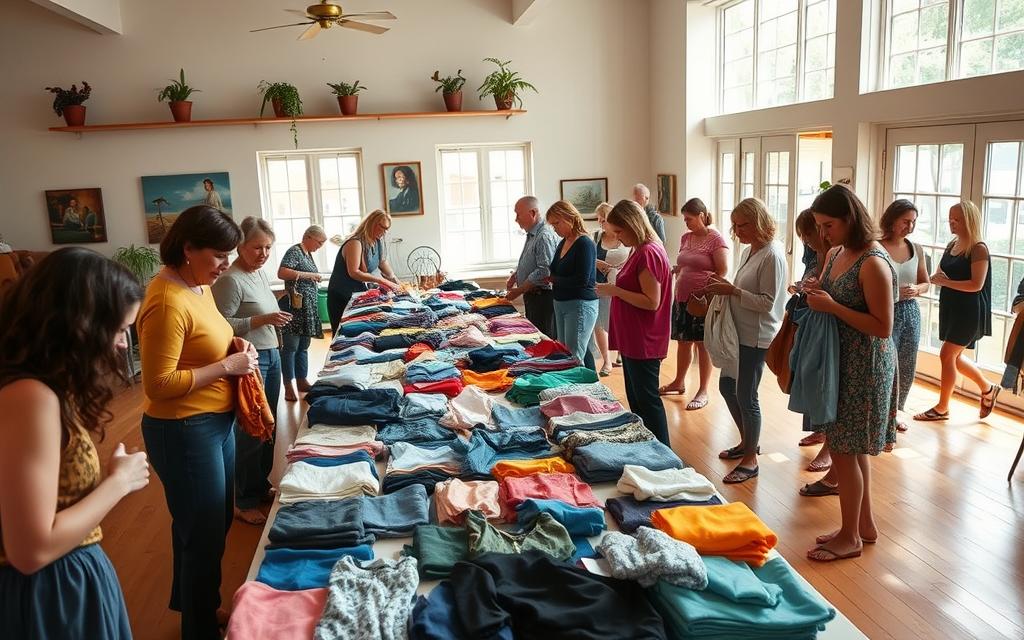Advertisement
Did you know the average American throws away 82 pounds of clothes each year? This shows we need to think about sustainable fashion. Joining a clothing swap is a great way to update your clothes without spending money. You can swap your gently used items for something new, making your style fresh and free.
Being part of a clothing swap helps the environment and refreshes your wardrobe. It’s a fun way to change your look, get rid of old clothes, and meet people. Whether you want a whole new wardrobe or just a few pieces, swapping clothes is a fun and affordable option.
What is a Clothing Exchange?
Clothing exchanges let you refresh your wardrobe while connecting with others. It’s an event where people swap gently used clothes and accessories.
It’s simple: bring clothes you don’t want and swap them for new ones. This way, you get to update your wardrobe without spending money. Plus, it helps the environment by reducing waste.
Understanding the Concept
A clothes exchange is more than swapping clothes. It’s about creating a community that values sustainable fashion. It’s an innovative approach to reuse clothes and lessen the fashion industry’s environmental impact.
Here’s how it works: everyone brings their gently used items. After a chance to browse, they swap them. You can do this at casual meetups or organized events.

Benefits of Clothing Swaps
There are many benefits to joining a clothing swap. You get to refresh your wardrobe for free and help the environment. Here are some key advantages:
| Benefit | Description |
|---|---|
| Sustainability | Reduces waste by giving old clothes a new life. |
| Community Building | Fosters connections among participants who share similar interests. |
| Wardrobe Refresh | Allows participants to update their wardrobes without spending money. |
By joining a clothing exchange, you’re not just updating your wardrobe. You’re also supporting a sustainable and community-driven fashion approach.
How to Find Local Clothing Swaps
Finding a local clothing swap is easier than you think. Many online resources and social media platforms can help. You can find a swap near you and refresh your wardrobe.
Online Resources for Identifying Events
Online resources are great for finding local swaps. Websites like Meetup.com and Eventbrite.com list swap events. You can also search for groups on Facebook or clothing swap websites.
Use keywords like “clothing swap near me” or “garment exchange in [your city].” This will help find events and groups in your area.
Social Media Platforms to Explore
Social media is a powerful tool for finding swaps. Instagram and Facebook have groups for clothing swaps. Join these groups to connect with others who love sustainable fashion.
Use hashtags like #clothing swap, #garment exchange, or #sustainable fashion. You can also search for local influencers or bloggers who might organize swaps.
Community Boards and Local Listings
Check community boards and local listings for swaps. Many cities have bulletin boards in coffee shops, libraries, or community centers. People post about upcoming events there.
Also, check local newspapers or online event calendars for swap listings. Some cities host swaps as part of larger events, like sustainability fairs or community gatherings.
| Resource | Description | Benefits |
|---|---|---|
| Meetup.com | Website listing various meetup groups, including clothing swaps | Easy to find and join local groups, RSVP for events |
| Facebook Groups | Social media platform with groups dedicated to clothing swaps | Connect with local community, share items, and participate in discussions |
| Local Community Boards | Physical or online boards listing local events | Find events in your immediate area, often with detailed descriptions |
Preparing for a Clothing Swap
Getting ready for a clothing swap is key to a great experience. You need to check your closet, pick items to swap, and make sure they’re in good shape.
Assessing Your Wardrobe
Start by going through your closet. Look for gently used clothes and accessories that are still in good condition. Think about the season and what items are likely to be popular.
For example, if it’s winter, bring your winter clothes. This way, your items are more likely to be swapped.
Selecting Items to Bring
After checking your closet, pick the items you want to swap. Think about the condition, quality, and if they’re still relevant. As
“The key to a successful swap is bringing items that are both desirable and in good condition.”
Items from popular brands and trendy pieces are usually more sought after.
Cleaning and Repairing Clothes
Before you bring your items, make sure they’re clean and fixed. A well-kept item is more likely to be chosen. Cleaning and repairing clothes makes them look better and shows respect for others.
To get ready, follow these steps:
- Check for stains and wash items as needed.
- Mend any tears or loose threads.
- Iron clothes to remove wrinkles.
By doing these steps, you’ll be ready for a successful preloved clothing exchange. The goal is to swap items that are in good condition and appealing to others.
The Swap Day: What to Expect
On the swap day, you can trade gently used clothes for new ones. It’s more than just swapping clothes. It’s a chance to meet new people and update your wardrobe for free.
Setting Up and Arriving Early
Getting there early is key. Many swaps follow a first-come, first-served rule. Arriving 30 minutes early helps you get the best picks.
The Swap Process Explained
At the swap, you get credits to “buy” items. It’s easy: pick what you like and use your credits. It’s a fun way to shop and declutter.
Tips for Successful Trading
Be ready to negotiate. Some swaps let you haggle. Also, be open to different items. You might find something you love unexpectedly.
If you don’t find what you want, it’s okay to leave. The goal is to have fun and find great deals. A clothing swap is a great way to refresh your style without spending money.
Etiquette for Clothing Exchanges
To make a clothing swap fun and smooth, knowing the etiquette is important. Clothing exchanges have rules that make the event good for everyone. These rules help everyone enjoy the swap.
Being Respectful and Inclusive
Respect and inclusion are key for a great apparel exchange. Be careful with others’ things and listen to their thoughts. Make sure your items are clean and in good shape. Being open to different items is part of the fun.
Respect goes both ways. It’s not just about how you treat others’ stuff. It’s also about how you want yours treated. Being ready to talk and flexible can make your experience better.
Understanding Fair Trading Practices
Fair trading is important in a garment exchange. Be honest about your items’ condition and don’t take advantage of others. A fair system might be “one-for-one” or “bring X, take Y.” This keeps things balanced.
| Etiquette Tip | Description | Benefit |
|---|---|---|
| Be Clean and Organized | Ensure your items are clean and neatly folded or hung. | Makes a good impression and shows respect. |
| Be Open-Minded | Be willing to consider different styles and sizes. | Enhances your shopping experience and fosters community. |
| Follow the Rules | Understand and adhere to the swap’s rules and guidelines. | Ensures a smooth and fair experience for all. |
By following these tips, a clothing swap can be a positive and fun event. It’s about building a community that values sustainability, respect, and fun.
Creative Ways to Style Newly Acquired Clothes
A clothing swap is more than just exchanging clothes. It’s a chance to find new fashion inspiration. With a fresh wardrobe from a fashion exchange or secondhand clothing exchange, you can refresh your style and explore new fashion paths.
Mixing and Matching for a Fresh Look
Mixing and matching different pieces is exciting when styling new clothes. Try pairing a new dress with a jacket you already have. Or, style a new top with a skirt for a fresh look. The goal is to experiment and enjoy the process.
Accessorizing to Enhance Outfits
Accessories can really make an outfit stand out. When styling new clothes, add a statement piece of jewelry or a vibrant scarf. A stylish hat can also add a personal touch. Accessories let you express your style and personality.
For example, a simple dress can look completely different with the right accessories. A bold necklace can make it glamorous for evening, while sunglasses add a chic, casual look. The right accessories can transform your outfits in countless ways.
Eco-Friendly Benefits of Clothing Swaps
Clothing swaps offer many eco-friendly benefits, making fashion more sustainable. They help reduce our environmental impact by using preloved clothes.
Clothing swaps are a smart way to tackle fashion waste. The fashion world is a big polluter. Swapping clothes helps cut down on waste that harms our planet.
Reducing Waste Through Upcycling
Upcycling is a big plus of clothing swaps. It turns old clothes into new, useful items. This way, we use less new resources and keep materials from ending up in landfills.
Benefits of Upcycling include:
- Reducing waste sent to landfills
- Conserving resources by reusing existing materials
- Creating unique, eco-friendly fashion pieces
Supporting Sustainable Fashion
Clothing swaps also support sustainable fashion. By swapping, we encourage a culture of reuse and recycling in fashion.
Sustainable fashion is more than just being green. It’s about being mindful of what we buy. Swaps help us see the value in items we might throw away.
By choosing swaps and sustainable fashion, we can make the fashion world better for our planet.
Hosting Your Own Clothing Swap
Looking for a creative way to update your style? Try hosting your own clothing swap. It’s a great way to refresh your wardrobe and build a community.
Planning and Organizing the Event
The first step is planning and organization. Pick a date and place that’s easy for everyone to get to. Think about using local businesses or community centers.
It’s important to know what kind of clothing swap you want. Are you swapping kids’ clothes or formal outfits? This helps you know who to invite.
Inviting Participants and Engaging the Community
After planning, it’s time to invite participants and get the community involved. Use social media, flyers, and local event calendars to spread the word. Make an event page on Facebook to keep everything in one place.
Make your swap more appealing with things like food, raffles, or workshops on sustainable fashion. Talking to local influencers or bloggers can also help draw more people.
Logistics: Venue, Supplies, and Promotions
Good logistics are crucial for a successful swap. Make sure your venue has tables, hangers, and bags for everyone to take their new clothes home.
Promotions are also key. Mix digital and physical ads to get people excited. Work with local businesses to promote your event and offer special deals.
With careful planning, your clothing swap can be a fun, engaging, and eco-friendly event for everyone.
Building a Clothing Swap Community
Creating a community around clothing swaps promotes sharing and sustainability. It connects people who love fashion and care for the environment. Together, they form a lively network that benefits everyone.
Networking with Local Fashion Enthusiasts
To start your community, begin by networking with local fashion enthusiasts. Use social media, local event calendars, and community boards to find people who share your interests. You can also go to local fashion events, join eco-friendly groups, or chat online about sustainable fashion.
Some good ways to network include:
- Creating a Facebook group or event page for your clothing swap community
- Using Instagram to show off your swaps and get followers
- Working with local boutiques or eco-friendly stores to host your events
- Going to local meetups or events about sustainable living
Forming Regular Swap Events
After you’ve built a network, start forming regular swap events. Regular events keep the community active. You might hold swaps seasonally or monthly, depending on your community’s size and interest.
To make your events successful:
- Choose a consistent schedule and venue
- Make clear rules and guidelines for participants
- Promote your events on social media and local ads
- Ask for feedback to keep improving the experience
By following these steps and keeping a welcoming atmosphere, you can grow a strong clothing swap community. This community not only updates wardrobes but also supports sustainable fashion.
Frequently Asked Questions About Clothing Swaps
If you’re new to clothing swaps, you might have questions or worries. Knowing the basics can make your experience better.
Common Concerns and Misunderstandings
People often wonder what to bring, how to swap, and what to expect. Being ready is crucial for a good swap. Tips include arriving early, being open-minded, and trying new things.
Tips for First-Time Swappers
First-timers should look at their closet and pick items in good shape. It’s important to be kind and fair during the swap. With preparation and a positive mindset, you’ll enjoy your swap.



